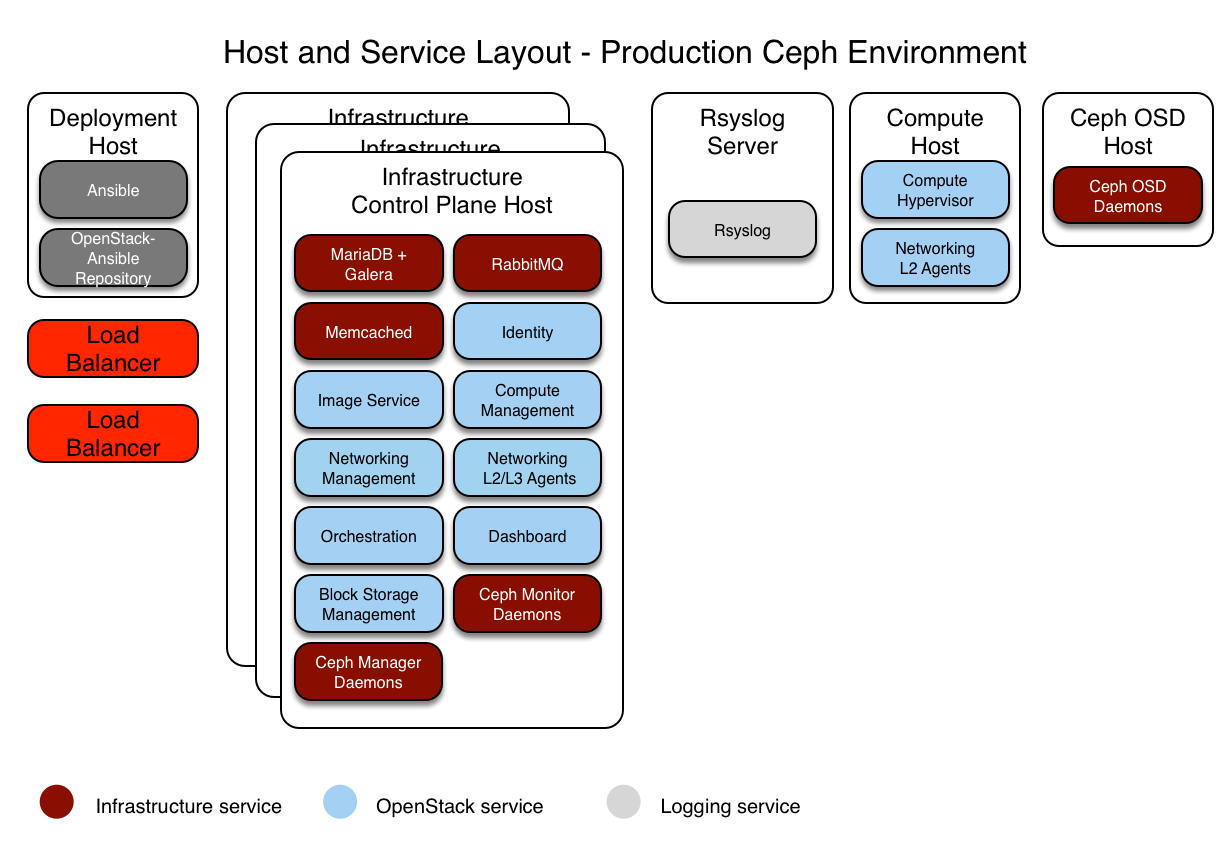There are details that confuse people (like the usage of may), when they are configuring a ceph environment. This should clarify the situation. Change-Id: Ic8b734eabcfa218c687db69290c8b3cef1def7c5
5.4 KiB
Appendix D: Example Ceph production environment configuration
Introduction
This appendix describes an example production environment for a working OpenStack-Ansible (OSA) deployment with high availability services and using the Ceph backend for images, volumes, and instances.
This example environment has the following characteristics:
- Three infrastructure (control plane) hosts with ceph-mon containers
- Two compute hosts
- Three Ceph OSD storage hosts
- One log aggregation host
- Multiple Network Interface Cards (NIC) configured as bonded pairs for each host
- Full compute kit with the Telemetry service (ceilometer) included, with Ceph configured as a storage back end for the Image (glance), and Block Storage (cinder) services
- Internet access via the router address 172.29.236.1 on the Management Network
Network configuration
Network CIDR/VLAN assignments
The following CIDR and VLAN assignments are used for this environment.
| Network | CIDR | VLAN |
|---|---|---|
| Management Network | 172.29.236.0/22 |
|
| Tunnel (VXLAN) Network | 172.29.240.0/22 |
|
| Storage Network | 172.29.244.0/22 |
|
IP assignments
The following host name and IP address assignments are used for this environment.
| Host name | Management IP | Tunnel (VxLAN) IP | Storage IP |
|---|---|---|---|
| lb_vip_address | 172.29.236.9 | ||
| infra1 | 172.29.236.11 | ||
| infra2 | 172.29.236.12 | ||
| infra3 | 172.29.236.13 | ||
| log1 | 172.29.236.14 | ||
| compute1 | 172.29.236.16 | 172.29.240.16 | 172.29.244.16 |
| compute2 | 172.29.236.17 | 172.29.240.17 | 172.29.244.17 |
| osd1 | 172.29.236.18 | 172.29.240.18 | 172.29.244.18 |
| osd2 | 172.29.236.19 | 172.29.240.19 | 172.29.244.19 |
| osd3 | 172.29.236.20 | 172.29.240.20 | 172.29.244.20 |
Host network configuration
Each host will require the correct network bridges to be implemented.
The following is the /etc/network/interfaces file for
infra1.
Note
If your environment does not have eth0, but instead has
p1p1 or some other interface name, ensure that all
references to eth0 in all configuration files are replaced
with the appropriate name. The same applies to additional network
interfaces.
../../etc/network/interfaces.d/openstack_interface.cfg.prod.example
Deployment configuration
Environment layout
The /etc/openstack_deploy/openstack_user_config.yml file
defines the environment layout.
The following configuration describes the layout for this environment.
../../etc/openstack_deploy/openstack_user_config.yml.prod-ceph.example
Environment customizations
The optionally deployed files in
/etc/openstack_deploy/env.d allow the customization of
Ansible groups. This allows the deployer to set whether the services
will run in a container (the default), or on the host (on metal).
For a ceph environment, you can run the cinder-volume in
a container. To do this you will need to create a
/etc/openstack_deploy/env.d/cinder.yml file with the
following content:
../../etc/openstack_deploy/env.d/cinder-volume.yml.container.example
User variables
The /etc/openstack_deploy/user_variables.yml file
defines the global overrides for the default variables.
For this example environment, we configure a HA load balancer. We
implement the load balancer (HAProxy) with an HA layer (keepalived) on
the infrastructure hosts. Your
/etc/openstack_deploy/user_variables.yml must have the
following content to configure haproxy, keepalived and ceph:
../../etc/openstack_deploy/user_variables.yml.prod-ceph.example
